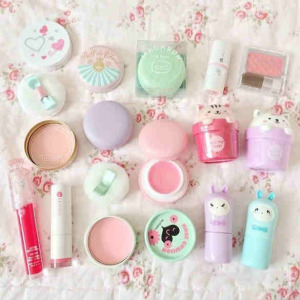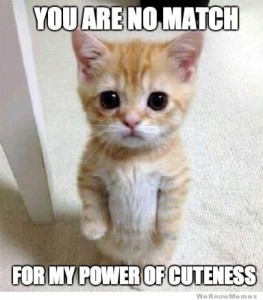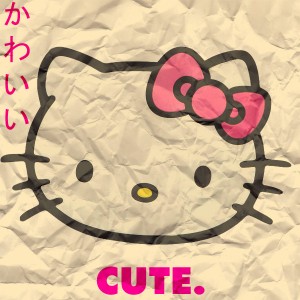By: Alice An
かわいい。귀여워. Cute.
There are so many different words that the world uses to describe the concept of cute.So what exactly does it mean? According to Sharon Kinsella, kawaii is a style in Japanese pop culture that essentially means childlike and “celebrates sweet, adorable, innocent, pure, simple, genuine, gentle vulnerable, weak, and inexperienced social behavior and physical appearances” (Kinsella 220). According to the Merriam-Webster dictionary, cute is defined to be “ attractive or pretty especially in a childish, youthful, or delicate way” (Merriam-Webster Dictionary). But what does cute actually look like in these countries?
Cute in Japan
In Japan, cute embodies itself in many different forms- from handwriting and stuffed animals to mannerisms, clothing, and makeup. In 1974, a growing number of teenagers, especially women, began to write using a new extremely stylized set of rounded characters with English, katakana, and little cartoon pictures like hearts, faces, and stars. In 1971, Sanrio, said to be the Japanese equivalent of Hallmark Cards, started to produce cute designs on stationary and fancy diaries for students to write in everyday with their cute handwriting. In the creation of these fanshi guzzu (fancy goods), Sanrio started to produce different merchandise such as stationary, toiletries, lunch boxes, bags, towels, stuffed animals, and other paraphernalia.
During the first half of the 1980s, the most fashionable design house in Tokyo, Pink House Ltd., started to produce cute outfits that were designed to make the wearer appear childlike and prim. Cute clothes started out as “simple white, pink and pastel shades for women and more sort of bright and rainbow-colored for men…often fluffy and frilly with puffed sleeves and lots of ribbons” (Kinsella 229). As Kinsella mentions in her article concerning the concept of cute in Japan, the demanding model of cute fashion created a desire towards the consumption of goods that would be able to transform a person to look and feel like a child. Cute fashion originally started as one that idolized childhood and depicted “playfulness, individual emotional expression, and naiveté…. not consistent with traditional social values” (Kinsella 250). However, cute took many different forms throughout the world.

Cute in South Korea
In South Korea, there are even different versions of the word cute to apply to different situations to describe different attributes. For example, 귀여워(gwiyuhwuh), can be used broadly to describe a child that is cute, an animal, a stuffed animal or anything that has cute attributes such as big eyes, round features, and/ or child-like characteristics. 애교 (aegyo) is a term that is used when describing a bubbly personality one may have that very much resembles a child. Women who have more aegyo are seen to be more attractive by many Asian men and are perceived to have a more innocent and attractive look to them because of their mannerisms. In addition, cute clothing has been made to appeal to mainstream culture and has become more acceptable in South Korea as well as many other Asian countries. The steady incorporation of bright color, ribbons, lace, and peter-pan collars are just a few characteristics of this gradual transition and acceptance of the cute style.
Effects of Cute Around the World
The influence of the notion of cute in Asia has seen its effects all over the world. Although cute may have started off in the form of more material goods, the transition across transnational borders has had an interesting impact on the aesthetics of beauty and what it means to be cute. Venus Isabelle Palermo, a popular YouTube star, was born and raised in Brugg, Switzerland and later moved to Spain where she started to upload videos of herself made up to look like a living doll and teaching viewers how to achieve this look. The videos gained attention worldwide and her video, “How to look like a doll” went viral in March 2012. From circle lenses and whitening skin products to lacy dresses and bows, Venus taught her viewers how to not only look cute but act cute as well. In the eyes of Venus and her avid fans and viewers, looking and acting cute is beautiful.
Commodification of Cute
 The perception of beauty is commodified- through not only its consumers but also those consumers who choose to advertise items such as circle lenses, lace dresses, ribbons, and various makeup items such as whitening creams. Cute has not only embodied itself in merchandise such as stuffed animals and stationary but has also entered into a realm of affecting the aesthetics of beauty and what it means to be beautiful. The emergence of cute culture was seen as an escape from reality- an escape into “childhood memories; nostalgia has been a door to people’s collective past” (Kinsella 252). But what can this imply about its transition to an aesthetic of beauty? As more and more women started to use this childlike escape, the innocence, purity, and naiveté associated with cute characteristics started to become more and more attractive to not only these women but also to men as well.
The perception of beauty is commodified- through not only its consumers but also those consumers who choose to advertise items such as circle lenses, lace dresses, ribbons, and various makeup items such as whitening creams. Cute has not only embodied itself in merchandise such as stuffed animals and stationary but has also entered into a realm of affecting the aesthetics of beauty and what it means to be beautiful. The emergence of cute culture was seen as an escape from reality- an escape into “childhood memories; nostalgia has been a door to people’s collective past” (Kinsella 252). But what can this imply about its transition to an aesthetic of beauty? As more and more women started to use this childlike escape, the innocence, purity, and naiveté associated with cute characteristics started to become more and more attractive to not only these women but also to men as well.
According to a popular blog post on the notion of cute, the author describes beauty as requiring “willpower, mastery, and effort” but the simplified image of cute does not have these qualities. Instead of challenging these notions, the author notes the cute has the purpose of soothing. This author argues that Japan loves cute because with the culture based on humility, being cute and helpless is not boasting your authority but rather being able to be whatever you want to be without repercussions- without “hiding….acting as free as if you were a child.” Cute style, she argues is an “anti-social style, because it is a pre-social style”, because it reverts back to a time when it was okay to be socially awkward and carries the connotation of not carrying social responsibility.
Perhaps it is the idea that not carrying social responsibility in turn connotes a young and innocent mind that is not tainted by the negative vibes of society. Perhaps it is for this exact reason that the perception of thinking younger means looking younger and that has carried over transnational borders to become a measure of beauty.
Discussion Questions
1. Do you think the definition of cute changes as it crosses transnational borders? Why or why not?
2. Do you think that the consumption of cute is seen primarily marked as Japanese? Or culturally odorless concept that could just be mass consumed by a wide audience?
3. Would you say that the notion of cute can also be reflected into Orientalist terms? That is to say, do you think that the Occident’s perception of cute is seen as “better” than the other? Why or why not?
4. Why do you think that the cute has become an aesthetic of beauty? Is it more of an attainable escapism from current reality, or a nostalgic turn toward the child-like innocent past, or just a fad?
Sources:
“Fifteen Theses on the Cute.” CABINET //. N.p., n.d. Web. 17 Apr. 2015.
“On Being Cute in Japan.” This Japanese Life. N.p., 30 Nov. 2011. Web. 17 Apr. 2015.
Related Links:
http://www.tofugu.com/2012/08/09/japan-why-so-kawaii/
http://www.travelfacts.com/kawaii-exploring-japans-infatuation-with-the-idea-of-cute/
http://web-japan.org/nipponia/nipponia40/en/feature/index.html



I do think the consumption of cute is primarily marked as Japanese, but I think your post shows that in time cute may be seen as more than Japanese as the trend spreads across the world. As well, I definitely think there is a factor of escapism present in cute, particularly in the makeup videos you included. It was a bit freaky watching the girls completely transform and abandon their natural appearance. Could this be connected to a lack of self confidence in oneself which is an experience for many girls across cultures. If so is that evidence that cute can permeate a variety of cultures? It made me wonder about other influence on body image cute culture has had. Primarily, is there an ideal body shape connected to the image of cute and if so has this caused girls to diet, exercise or take other measures to achieve a certain body shape. Additionally, I would be interested to know how cute is related to sexual expectations of women for themselves and for men.
If I remember correctly, the cute culture began as a way for girls to reclaim their femininity and not be subject to the male gaze. Now with what you have said, it is just another way to uphold societal definitions of beauty. You also mention skin whitening creams a lot. There has been a lot of international outrage that these creams uphold racism and colorist, equating paleness with beauty and saying that anybody who is darker is not beautiful.
I have also noticed that cute has become sexualized. Does this tie into pedophilia, power fantasies, and the idea that women, particularly Asian women, are submissive and innocent?
I am very curious about the relationship between the Japanese and South Korean iterations of cuteness that you describe in your post. There seems to be at least some sort of visual influence that the Japanese cute has on South Korean cute, but is there a direct lineage from one to the other? Does each country have their own specific brand of cute, considering your emphasis on commodification, or is it rather a lose trade of cute signifiers and commodities between Japan and South Korea? Also, is it not possible to further distinguish between the cute aesthetic (the commodified aspect) and the cute subculture? The article seems to discuss them both under the single blanket term of “cute” while it seems to me as if they are distinct entities. This could also lead into a discussion of the historical tendency to commodify subcultures for mainstream markets.
Thank you, good article.
–
Lesbian News
Ankara Antikacılık